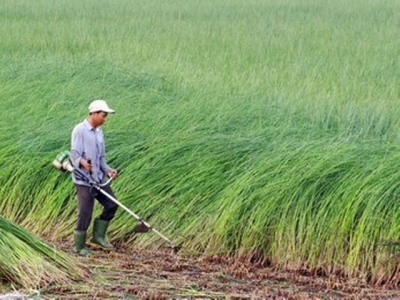Mekong farmers switch to growing lemongrass

Ho Chi Minh City – More rice farmers in Tiền Giang Province’s Tân Phú Đông District have switched to planting lemongrass as part of the district’s agricultural restructuring to adapt to climate change.
Farmers in Tiền Giang Province’s Tân Phú Đông District sort lemongrass after harvest. - VNA/VNS Photo Nam Thái
The district now has the largest lemongrass planting area in the Cửu Long (Mekong) Delta province.
Lê Văn Tốt, residing in Tân Phú Đông’s Phú Thạnh Commune, said previously he had planted rice but the crop had low yields because of harsh natural conditions.
The profits he earned from planting lemongrass are three times higher than those from rice, he said.
In the dry season, the islet district of Tân Phú Đông is affected by saltwater intrusion and farmers can only plant one rice crop in the rainy season.
Previously, rice fields were left vacant in the dry season because of a shortage of fresh water.
In recent years, many rice farmers have switched to lemongrass because it is easy to grow, and is resistant to saltwater intrusion and diseases.
In the dry season, lemongrass is resistant to saltwater, with a salt content reaching three to four grammes per litre of water.
With an annual yield of 15 tonnes per ha, farmers can earn a profit of VNĐ35 – 45 million (US$1,500 - 2,000) per ha each year.
Nguyễn Văn Hải, head of the district’s Agriculture and Rural Development Bureau, said the district has more than 1,500ha of lemongrass with an annual yield of 22,000 tonnes.
Most lemongrass planting areas are in the district’s Phú Thạnh, Phú Đông and Phú Tân communes. Lemongrass is planted in former rice fields, around houses and any vacant land.
The district’s lemongrass is sold in the province and other places, including HCM City.
The planting of lemongrass in the district has also created jobs for many local labourers who are hired to harvest, classify and clean lemongrass.
The district has identified lemongrass, sour sop, coconut and high-yield rice as key plants for the 2015-20 period.
Established in 2008, Tân Phú Đông was once a poor district but now around 65 per cent of households are well off, according to local authorities.
Có thể bạn quan tâm
 VN farm products export to Thailand
VN farm products export to Thailand Its first batch of farm exports comprise yellow sweet potato, purple sweet potato, dragon fruit, dried fruits, and rice paper.
 How to formulate a low-protein animal diet
How to formulate a low-protein animal diet An easy process to understand how feed-grade amino acids and crude protein specifications interact to form a balanced low-protein diet
 Seeking markets for lychee fruit
Seeking markets for lychee fruit When every lychee season comes, the provincial People’s Committee of Bac Giang province (PPC) and its related agencies join hands to find the markets.